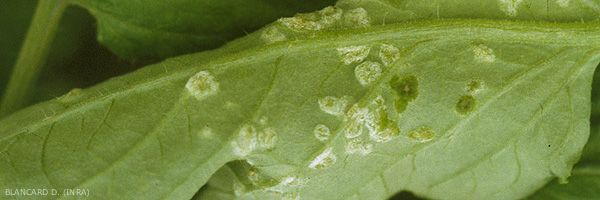
Intumescence on leaves
Chlorotic spots more or less distributed near the veins appear on the lower leaves (figure 1). In fact, these spots form when the water balance between root absorption and plant evapotranspiration is disturbed, the latter absorbing more water than they can remove under shelter conditions. This then results in water saturation of the leaf tissues, causing intumescence . These correspond to islands of cells, located on the underside of the limbus, which have become “engorged” with water, sometimes leading to a rupture of the epidermis. Thus edemas with a wet to oily appearance are formed (figures 2). The cells eventually burst and the curing tissue takes on a brownish tint (Figures 3 and 4). In particularly humid conditions, the presence of a large number of intumescences leads to the deformation and curling of many leaflets (figure 5).
Intumescences are caused by a physiological disease of the tomato which mainly occurs in crops under cover at particularly humid periods (in late winter, early spring or autumn) and / or following sudden changes in climate nocturnal (high humidity, low temperatures). It often affects many plants distributed over the whole crop or located in the cold, wettest places of the shelters. Low light intensities, poor air circulation and high plant densities are likely to promote the expression of intumescences ( edema ).
Although sometimes very spectacular, this non-parasitic disease is normally of no consequence for tomato crops, provided however that the climate of the shelters is quickly corrected. Among the measures to prevent intumescence, we can advise you:
- to use a soil or a well draining substrate;
- avoid excessive planting densities;
- reduce the humidity level in shelters by heating and ventilating early in the morning and in the morning;
- to control irrigation well, especially during cloudy and humid periods. It will be stopped at the end of the afternoon, before nightfall, in order to prevent the soil or the substrate from remaining too wet.
Intumescences are caused by a physiological disease of the tomato which mainly occurs in crops under cover at particularly humid periods (in late winter, early spring or autumn) and / or following sudden changes in climate nocturnal (high humidity, low temperatures). It often affects many plants distributed over the whole crop or located in the cold, wettest places of the shelters. Low light intensities, poor air circulation and high plant densities are likely to promote the expression of intumescences ( edema ).
Although sometimes very spectacular, this non-parasitic disease is normally of no consequence for tomato crops, provided however that the climate of the shelters is quickly corrected. Among the measures to prevent intumescence, we can advise you:
- to use a soil or a well draining substrate;
- avoid excessive planting densities;
- reduce the humidity level in shelters by heating and ventilating early in the morning and in the morning;
- to control irrigation well, especially during cloudy and humid periods. It will be stopped at the end of the afternoon, before nightfall, in order to prevent the soil or the substrate from remaining too wet.





